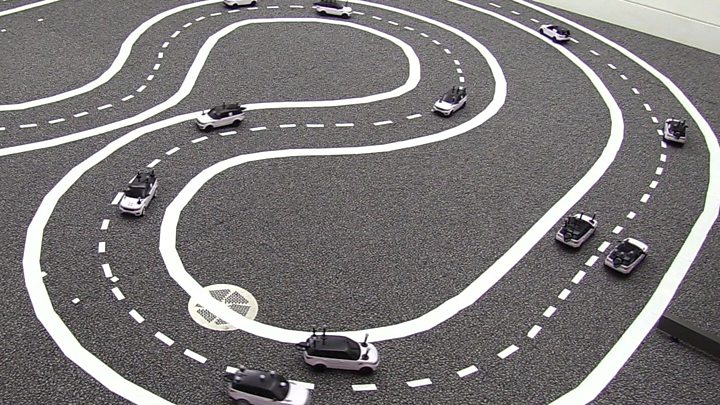
Media playback is unsupported on your device
Driverless cars working together can improve traffic flow by 35%, a study using model vehicles has found.
Cambridge University researchers programmed 16 miniature cars to drive on a two-lane track to see how they fared when one of them stopped.
Traffic queues formed, but when the cars’ communication system was turned on, they slowed down to allow each other to pass the stationary car.
The study hopes it will fix “problems associated with driving in cities”.
The researchers adapted the 1:24-scale cars with motion capture sensors and a Raspberry Pi, a credit card-sized computer, so the cars could communicate via Wi-Fi.
When it was turned on, cars coming in the opposite direction slowed down to let cars stuck behind the stationary vehicle overtake it.
When a human-controlled car driving in an aggressive manor, was put on the track, the other autonomous cars gave way to it, improving safety.
The study’s co-author Michael He, an undergraduate at Cambridge’s St John’s College, said: “Autonomous cars could fix a lot of different problems associated with driving in cities, but there needs to be a way for them to work together.”
Co-author Nicholas Hyldmar, a student at Downing College, said: “If different automotive manufacturers are all developing their own autonomous cars with their own software, those cars all need to communicate with each other effectively.”
The researchers concluded that when cars were in “non-aggressive” mode and were in “co-operative” rather than “egocentric” mode, traffic flows improved by 35%.
The 20cm (8in) by 8cm (3in) cars were built using mainly off-the shelf components and cost about £60 each, researchers said.
The results are being presented at the International Conference on Robotics and Automation in Montreal, Canada this week.
The Cambridge researchers hope to introduce the model cars to more complex scenarios, such as more lanes, intersections and a wider range of vehicle types.
